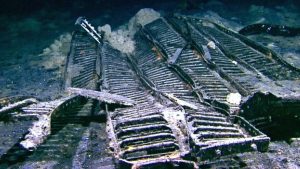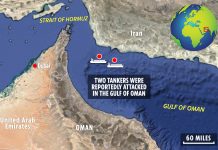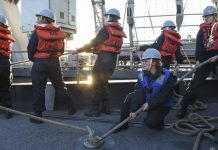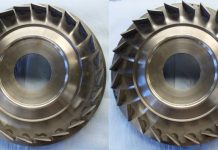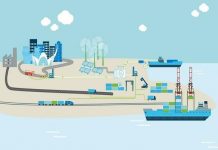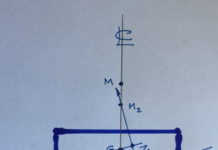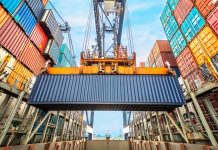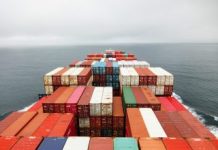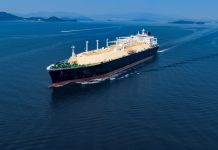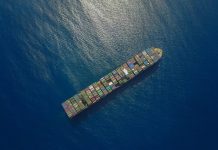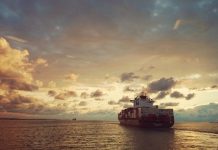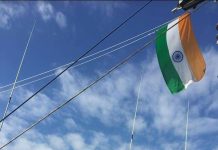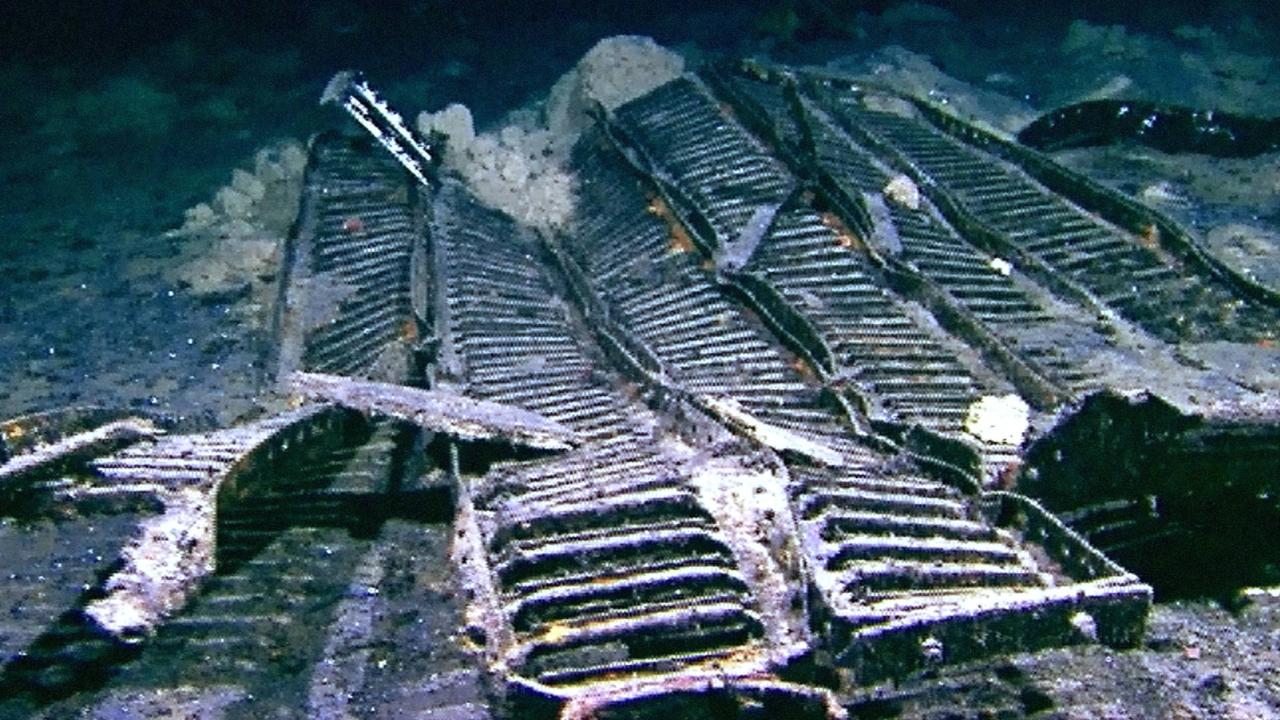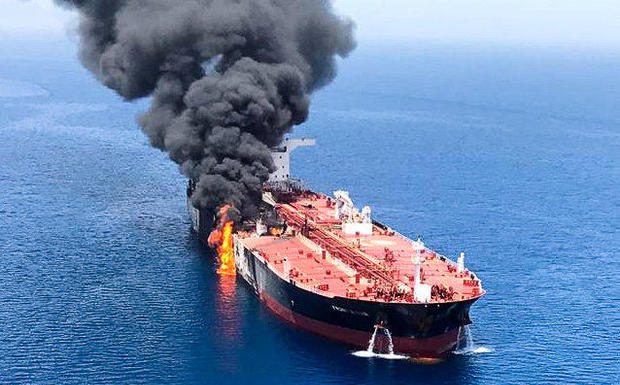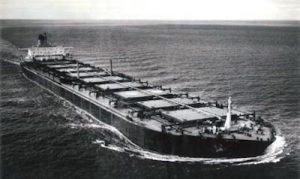
The disappearance of the MV Derbyshire in 1980 was a shock to many in the world of shipping. In the 1970s and 80s, bulk carriers were sinking at a rate one ship lost every three to six weeks, usually with the loss of all hands. Many of these bulkers were older, often literally worn-out, poorly maintained with ill-trained crews, and operated by fly-by-night owners.
MV Derbyshire was an ore-bulk-oil combination carrier built in 1976 by Swan Hunter, as the last in the series of the Bridge-class sextet. She was registered at Liverpool and owned by Bibby Line.
She was lost on 9 September 1980 during Typhoon Orchid, south of Japan. All 42 crew members and two of their wives were killed in the sinking. At 91,655 gross register tons, she is the largest British ship ever to have been lost at sea.
The mysterious sinking of the Capesize Ore/Bulk/Oiler MV Deryshire, with the loss of 42 aboard, in Typhoon Orchid in 1980. To this day, the Derbyshire remains the largest British flagged ship ever to have been lost at sea. What happened to the mighty ship would be a perplexing mystery and the subject of considerable controversy for more than twenty years.
In 1978, Liverpool Bridge was renamed Derbyshire, the fourth vessel to carry the name in the company’s fleet. On 11 July 1980, on what turned out to be the vessel’s final voyage, Derbyshire left Canada, her destination being Kawasaki, Japan, though she foundered near Okinawa (Southern Japan). Derbyshire was carrying a cargo of 157,446 tonnes of iron ore.
THE COFFIN SHIP
On 9 September 1980, Derbyshire hove-to in Typhoon Orchid some 230 miles from Okinawa, and was overwhelmed by the tropical storm killing all aboard. It was en route from Canada to Japan carrying nearly 160,000 tons of iron ore when the captain received word there was a typhoon coming his way. Derbyshire never issued a Mayday distress message. The vessel had been following weather routing advice by “Ocean routes”, a commercial weather routing company.
The search for Derbyshire commenced on 15 September 1980 and was called off six days later when no trace of the vessel was found, and it was declared lost. Six weeks after Derbyshire sank, one of the vessel’s lifeboats was sighted by a Japanese tanker.
In 1980, MV Derbyshire was Three conflicting weather reports predicted a different paths for the storm, so he altered course to avoid all three. But his strategy didn’t work and MV Derbyshire soon found itself rocked by huge waves and violent winds. The ship’s last radio call to shore reported they were heaving to and were going wait out the storm. It was the last time anyone heard from the ship. When they failed to reach their destination, a massive search operation was launched, but it turned up no debris from the ship and no sign of any survivors. All 42 people on board are dead.
The UK government at first refused to investigate but the families of the dead demanded answers.
The Derbyshire was a huge vessel at 965 feet long and 145 feet wide and was operated by an experienced captain and crew. The vessel should have been capable of withstanding a violent storm, even a typhoon. With the government refusing to hunt for the wreck, the families realized it would be up to them to find answers.
CONDITION OF THE SHIP
The Derbyshire was not one of these ships. She was almost new, well maintained, with a capable British crew and operated by a well-respected British shipping company. Almost 1,000 feet long and 170,000 DWT, she was a Capesize ship, too large to fit through either the Panama or Suez canals. She was one of the largest bulk carriers of her day, designed to sail beneath Cape Horn and the Cape of Good Hope in the Southern Ocean, in some of the most brutal seas in the world.
If any ship should be able to ride out a typhoon, it should have been the Derbyshire, yet she vanished south of Japan without issuing a distress call. When searchers scoured the area looking for survivors, no trace of the ship was found, other than an oil slick near where she sank in waters over two miles deep.
BEFORE DROWNING
One other thing made the Derbyshire different from other bulk carriers which disappeared. The English crew, who died when the ship went down, had families waiting for them at home. The Derbyshire families demanded an answer to the question — why, of all ships, did the Derbyshire sink? For more than two decades, the Derbyshire families would wage a dogged campaign to find that answer. The end result would, ultimately, rewrite the rule books and make bulk carriers around the globe significantly safer.
After the loss of her sister ship MV Kowloon Bridge off the coast of the Republic of Ireland in 1986, after a series of events precipitated by deck cracking discovered after an Atlantic crossing, the Derbyshire investigation was re-opened by the relatives of the victims of the sinking. With financial support from the Seafarers Union in 1994 a deep water search began.
THE WRECKS OF Derbyshire
In June 1994, the wreck of Derbyshire was found at a depth of 4 km, spread over 1.3 km. An additional expedition spent over 40 days photographing and examining the debris field looking for evidence of what sank the ship. Ultimately it was determined that waves crashing over the front of the ship had sheared off the covers of small ventilation pipes near the bow. Over the next two days, seawater had entered through the exposed pipes into the forward section of the ship, causing the bow to slowly ride lower and lower in the water. Eventually, the bow was completely exposed to the full force of the rough waves which caused the massive hatch on the first cargo hold to buckle inward allowing hundreds of tons of water to enter in moments. As the ship started to sink, the second, then third hatches also failed, dragging the ship underwater. As the ship sank, the water pressure caused the ship to be twisted and torn apart by implosion.
